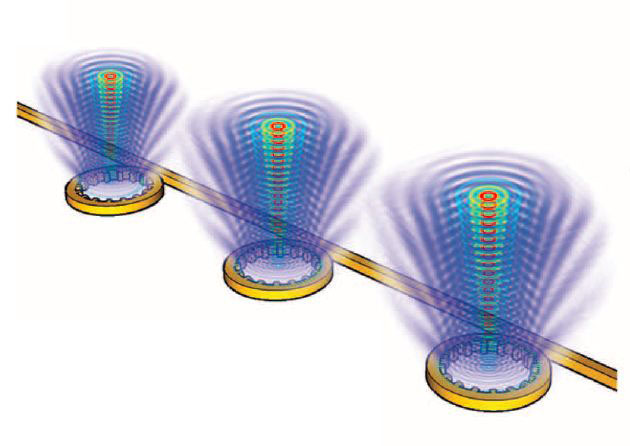Optical vortex beams on a chip
October 23, 2012

Illustration of an array consisting of three identical emitters. The three-dimensional emission pattern is calculated with the use of a dipole-emission-based semianalytical model. (Credit: Yue Zhang)
An international research group has demonstrated integrated arrays of emitters of “optical vortex beams” on a silicon chip.
Light in such beams does not propagate in straight rays. Instead, it travels in a spiral fashion in a hollow conical beam shape.
In quantum mechanics, this feature is associated with the orbital angular momentum (OAM) of photons.
When such light interacts with matter, it asserts a rotational force (torque) on the matter, so it can be used as “optical spanners” and “optical tweezers,” which can trap microscopic particles or droplets.
Different degree of twist can also be used to transmit information — allowing more information to be carried by a single optical signal, and increasing the capacity of optical communications links.
Light beams at the same frequency but with different OAM values can be used to transmit different streams of information. Single particles of light (photons) can use these different degrees of twist to represent quantum information, where a single photon can be twisting both clockwise and anti-clockwise at the same time.
Applications are also being developed in using such light for imaging and sensing purposes. For example some molecules are chiral — they look the same under normal optical microscopes until illuminated by optical vortex beams with different degrees or directions of twist.
Conventionally. the generation of such beams relied on bulk optical elements such as plates, lenses, and holograms. These are good for research but can be inconvenient for many applications, in particular where large numbers of such beams are needed at high packing density.
In contrast, the new emitters invented at Bristol University are only a few microns in size and thousands of times smaller than conventional elements. They are based on silicon optical waveguides and can be made using standard integrated circuit fabrication technologies.
Siyuan Yu, Professor of Photonics Information Systems in the Photonics Research Group at the University of Bristol, who led the research, said: “Our microscopic optical vortex devices are so small and compact that a silicon microchip containing thousands of emitters could be fabricated at very low cost and in high volume. Such integrated devices and systems could open up entirely new applications of optical vortex beams previously unattainable using bulk optics.”
These devices are readily interconnected with each other to form complex and large arrays in photonic integrated circuits, and could be used for applications including communications, sensing and microscopic particle manipulation.
Podcast interview: From the Science Podcast: Science‘s Edward Hurme speaks with Siyuan Yu on transferring information by giving orbital angular momentum to light.